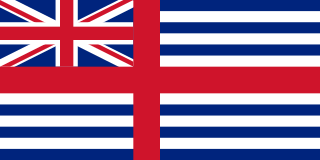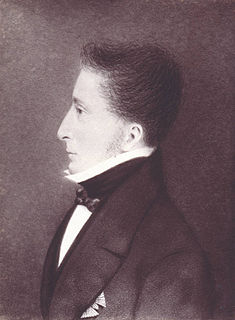
Tasmania is an island state of Australia. It is located 240 km (150 mi) to the south of the Australian mainland, separated by Bass Strait. The state encompasses the main island of Tasmania, the 26th-largest island in the world, and the surrounding 334 islands. The state has a population of about 540,600 people as of June 2020. The state capital and largest city is Hobart, with around 40 percent of the population living in the Greater Hobart area.

Van Diemen's Land was the first name used by most Europeans for the island of Tasmania, part of Australia. The name was changed from Van Diemen's Land to Tasmania in 1856.

Sir George Arthur, 1st Baronet was Lieutenant Governor of British Honduras from 1814 to 1822, Van Diemen's Land from 1823 to 1837. The campaign against Aboriginal Tasmanians, known as the Black War, occurred during this term of office. He later served as Lieutenant Governor of Upper Canada from 1838 to 1841, and Governor of Bombay from 1842 to 1846.

Flinders Island, the largest island in the Furneaux Group, is a 1,367-square-kilometre (528 sq mi) island in the Bass Strait, northeast of the island of Tasmania. Flinders Island is part of the state of Tasmania, Australia. It is 54 kilometres (34 mi) from Cape Portland and is located on 40° south, a zone known as the Roaring Forties.

The Midland Highway is one of Tasmania's major inter-city highways, running for 176 kilometres (109 mi) between Hobart and Launceston. It is part of the AusLink National Network and is a vital link for road freight to transport goods to and from the two cities. It represents a major north–south transportation corridor in Tasmania and has the route 1 designation as part of the National Highway. The highway consists of various traffic lane arrangements, the most common being two lanes – one in each direction, with overtaking options and at-grade intersections. At both the Launceston and Hobart sections of the highway there are small portions of grade-separated dual carriageway.

Colonel William Paterson, FRS was a Scottish soldier, explorer, Lieutenant Governor and botanist best known for leading early settlement at Port Dalrymple in Tasmania. In 1795, Paterson gave an order that resulted in the massacre of a number of men, women and children, members of the Bediagal tribe.

Colonel David Collins was a British administrator of Britain's first Australian colonies.

The West Coast of Tasmania has a significant convict heritage. The use of the West Coast as an outpost to house convicts in isolated penal settlements occurred in the eras 1822–33, and 1846–47.

The Royal Hobart Hospital is a public hospital in the Hobart CBD, Tasmania, Australia. The hospital also functions as a teaching hospital in co-operation with the University of Tasmania. The hospital's research facilities are known as the Royal Hobart Hospital Research Foundation. Also close to the hospital site is the Menzies Research Institute.
Federal Group is a privately owned family company which operates tourism, hospitality, retail, and a national sensitive freight company but are primarily known for their casino and gaming assets in Tasmania which is described as a "a licence to print money". In the past the company has been known as both "Federal Hotels" or "Federal Hotels and Resorts". Federal Group is Tasmania’s largest private sector employer with employees located across the entire state.

William Sorell was a soldier and third Lieutenant-Governor of Van Diemen's Land.

Sir John Eardley Eardley-Wilmot, 1st Baronet was a politician in the United Kingdom who served as Member of Parliament (MP) for North Warwickshire and then as Lieutenant-Governor of Van Diemen's Land.

SS Loongana was a Bass Strait passenger ship initially owned by Union Steamship Company of New Zealand. In 1922 she was transferred to Tasmanian Steamers Pty Ltd. SS Loongana was in service between 1904-1934 and was the first ship registered in the Southern Hemisphere with steam turbine propulsion. During the 1912 North Mount Lyell Disaster she crossed the strait in 12 hours and 46 minutes at 22 knots, carrying rescue gear from Victorian mines.

Thomas Davey was a New South Wales Marine and member of the First Fleet to New South Wales, who went on to become the second Lieutenant Governor of Van Diemen's Land.
The Tasmanian Historical Research Association is a Hobart based Tasmanian historical group and publisher in existence since 1951.
Tasmania, given its small geographic size and population has a flourishing literary culture. Historically Tasmania provides a fascinating literary background with visits from early European explorers such as the Dutchman Abel Tasman, the Frenchmen Bruni d'Entrecasteaux and Marion du Fresne and then the English explorers Matthew Flinders and George Bass. The colonisation of Tasmania was characterised by deteriorated relations with the indigenous Aboriginal people and a harsh convict heritage. These early elements of Tasmanian history are found both in the large number of colonial sandstone buildings and in the place names. Environmentally, Tasmania's picturesque landscapes and changeable weather, provide a vivid backdrop to Tasmanian literary culture. Tasmania's geographical isolation, rich creative community, proximity to Antarctica, controversial colonial past, bourgeoning reputation as a dynamic centre for the arts, and status as an island state, are some of the influences found in the island's significant collection of literature.
Frank Long was a trackcutter and prospector. In 1882 he discovered the Zeehan-Dundas silver-lead field on the West Coast of Tasmania.
The Australian Labor Party , commonly known as Tasmanian Labor, is the Tasmanian branch of the Australian Labor Party. It has been one of the most successful state Labor parties in Australia in terms of electoral success.

Chin Kaw, also known as Ah Kaw or Ah Caw, was a prominent Chinese Australian storekeeper, philanthropist, and mining entrepreneur in Launceston, Tasmania, Australia, who recruited workers from China for the Tasmanian tin-mining industry and thereby helped Chinese immigrants settle in Australia.
James Chung Gon, was a prominent Chinese Australian storekeeper, tin miner, market gardener, and Baptist lay preacher in Launceston, Tasmania, Australia, who became the leader of the Tasmanian Chinese community by the time of his death at 97, and was instrumental in organising the removal of the Weldborough joss house to the Victoria Museum in Launceston in the 1930s.